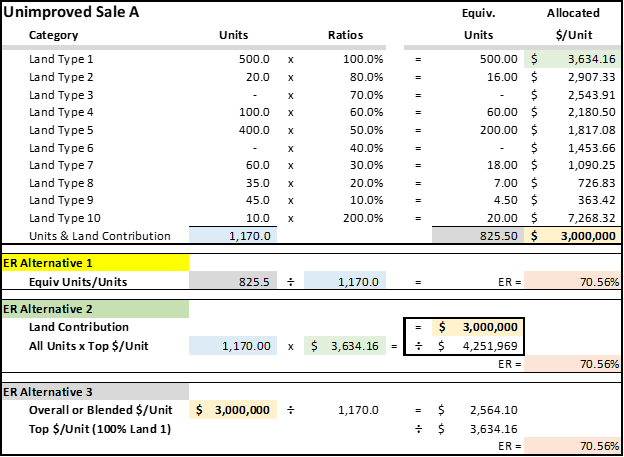ER Theory
![]()
The ER (equivalency rating) is a mathematical expression of each sale's land-mix or composition. The ER replaces the ASFMRA’s traditional “land-mix” procedure that contained multiple computations. The process converts the “land contribution” within each sale to a mathematical percentage, an expression of the “whole”. To begin ER, subject ratios are required to express its mathematical composition (74.48% below).
The graphics below are:
- Subject's equivalent units and ER calculated from ratios
- Then, one (1) unimproved Sale and
- one (1) improved Sale were reduced to the same mathematical “expression” or Equivalency Ratio to ultimately compute the “land-mix” adjustment for each.

When this process is repeated for each sale, the percent change between the sales and subject provide the basis for a simple calculation for the differences in “land-mix” or composition disparities. Two sales are shown below, i.e., one unimproved and one improved; plus, three (3) ways to compute the Sale ER’s.
Note for Alternative 2 below: The $3,000,00 “Land Contribution” is divided by the “Gross Units x Top $/unit” or 1,170 gross units x $3,634.16/acre for Land Type 1 = $4,251,969 which becomes the denominator for the calculation shown inside the smaller box ($3,000,000 ÷ $4,251,969 = 70.56%).


The land-mix calculations are shown below:

The % change for each sale is multiplied by its corresponding $/acre to calculate the proper land-mix adjustment by comparison to the Subject.
NOTE: If the Subject is improved, an additional adjustment may be required — to both sales. Even though Sale B is improved, the structures may be different sizes, condition, and remaining effective ages and require additional consideration(s), or “+, -, or =” calculations for its final impact on the final price per acre.
